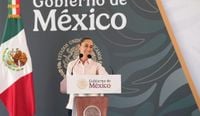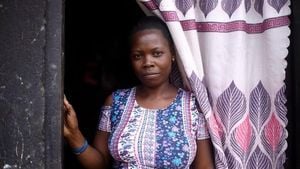On August 17, 2025, Mexican President Claudia Sheinbaum stood before a crowd in Ecatepec, one of the country’s most populous municipalities, and delivered a message that resonated far beyond the walls of the newly inaugurated Family Medicine Unit No. 93 of the Mexican Social Security Institute (IMSS). With a sense of accomplishment, she announced, “Mexico has the lowest percentage of population in poverty in 40 years.” It was a declaration backed by numbers and by what she called a “hazaña”—a feat that, for many, seemed almost unthinkable just a decade ago.
The data, recently released by the National Institute of Statistics and Geography (INEGI), was striking: between 2018 and 2024, 13.4 million Mexicans left poverty. The poverty rate, which had stubbornly resisted change for decades, finally tumbled, reaching its lowest level since the early 1980s. Even more remarkable, the income gap between the richest and poorest Mexicans narrowed sharply. Where the wealthiest once earned 38 times more than the poorest (as measured between 2006 and 2012), that figure had fallen to 14 times by 2024. According to Sheinbaum, “The National Household Income and Expenditure Survey showed, just a week ago, that social differentiation between the richest and the poorest decreased. During 40 years, poverty had not diminished in our country. On the contrary, it increased. Now, this result shows that the population in poverty is less, and people live with greater well-being.” (Infobae, EFE)
So, what changed? Sheinbaum credits a new model of development, one that upended the old orthodoxy of privatization and government retreat. She was direct in her criticism of the previous neoliberal approach, which, from 1982 to 2018, “promoted the idea that everything should be private, that the government was incapable of providing services,” and which, in her view, left public institutions weakened. “They didn’t privatize more only because it wasn’t allowed. The IMSS wasn’t privatized thanks to the workers and their union,” she said. (EFE, Infobae)
This new direction, Sheinbaum argued, is built on four main pillars: a historic increase in the minimum wage, the expansion and strengthening of social welfare programs, strategic public works, and a surge in private investment. The numbers are hard to ignore. The average salary for formal workers is now at its highest level ever. In 2025, the minimum wage rose by 12.5%, and Sheinbaum pledged that it would keep rising until it covers the cost of 2.5 basic food baskets—currently, it covers just 1.8. “We are going to keep increasing the minimum wage until it is enough for 2.5 basic baskets,” she promised during the inauguration. (EFE, Infobae)
The government’s social programs have also expanded dramatically. Welfare spending in 2025 reached 850 billion pesos (about $42.5 billion), supporting millions of families. Notably, the pension for older adults—now a constitutional right—provides 6,200 pesos (around $310) every two months to 13 million people. “Before, programs were targeted at a few populations; today, new rights have been created,” Sheinbaum explained. (EFE, Infobae)
Strategic public works have played a starring role as well. Projects like the Southeast Mexico Train, the Maya Train, and the Isthmus of Tehuantepec Train have injected investment and jobs into regions long neglected by federal policy. In 2024, Mexico saw a record influx of foreign direct investment, further boosting employment and economic activity. Regulatory changes, such as the elimination of outsourcing, have strengthened labor incomes and improved the distribution of profits. “The model of development changed: before, resources were destined for a few; now, they are allocated thinking of those who have the least,” Sheinbaum said, underscoring her government’s guiding principle: “For the good of all, first the poor.” (EFE, Infobae)
The impact of these policies was visible in Ecatepec, where Sheinbaum inaugurated the new Family Medicine Unit No. 93. The facility, rebuilt after the 2017 earthquake with an investment of 435 million pesos, is designed to serve 352,000 rights holders and handle 345,000 consultations annually. It boasts 51 consultation rooms, X-ray and ultrasound diagnostics, continuous medical admission, extended hours, and plans for a permanent CT scanner. The inauguration, attended by Health Secretary David Kershenobich, State of Mexico Governor Delfina Gómez, and IMSS Director Zoé Robledo, marked more than just a ribbon-cutting—it was a symbol of the government’s commitment to public health. (EFE, Infobae)
And the investment doesn’t stop there. IMSS has allocated 12.438 billion pesos (about $621.9 million) for four new hospitals and the construction or replacement of six Family Medicine Units across the region. IMSS-Bienestar, the branch focused on informal workers, is investing 4.19 billion pesos (about $209.5 million) to strengthen 17 hospitals, 180 medical units, and 57 operating rooms. The transfer of the Oncologic Hospital of Ecatepec to IMSS was also formalized, and Sheinbaum reiterated her administration’s goal of achieving a unified public health system by 2027—one that integrates IMSS, IMSS-Bienestar, and ISSSTE, so that, as she put it, “the State can provide access to health in the best way possible.” (EFE, Infobae)
Beyond health, the government’s plans for Ecatepec are ambitious. They include the establishment of a childcare and education center (CECI) on a 3,500-square-meter site, the creation of universities in each of the ten eastern municipalities, the repaving of streets, rehabilitation of wells, integration into the Mexico Valley metropolitan area program, and investments in pumping stations to prevent flooding. For a municipality of 1.7 million people—the third most populous in Mexico—these projects are not just welcome; they’re essential. (EFE, Infobae)
Of course, not everyone is convinced. Some critics, including former Coneval Secretary Gonzalo Hernández Licona, have pointed out that changes in INEGI’s survey methodology make it difficult to assess whether poverty truly fell or if the numbers reflect statistical adjustments. Others argue that while social programs are effective, their sustainability over decades remains to be seen. Yet, for the government and its supporters, the evidence is clear: “With the Fourth Transformation, a feat has been achieved to reduce poverty in the country,” said Senator Ricardo Monreal, who believes the social programs can endure for generations. (Infobae, EFE)
As Sheinbaum concluded her remarks in Ecatepec, she called attention to the broader significance of these changes. “There are some who don’t like us, who don’t agree with the Fourth Transformation, who find it impossible to recognize this result,” she said. “But not only did 13.4 million Mexicans leave poverty, the National Household Income and Expenditure Survey also showed that the wealth gap has narrowed. In other words, wealth is being distributed.” (Infobae)
With the unveiling of new clinics, expanded social programs, and a reimagined approach to economic growth, Sheinbaum’s government is betting that these gains are just the beginning. For millions of Mexicans, the hope is that this historic reduction in poverty and inequality will not be a fleeting achievement, but the foundation for a more equitable future.




